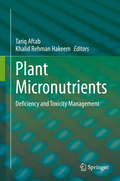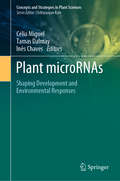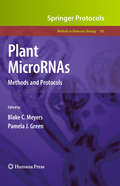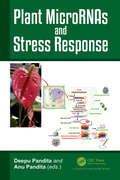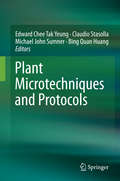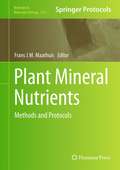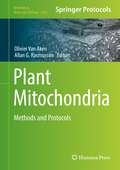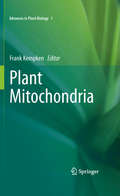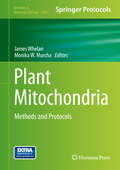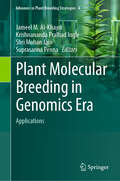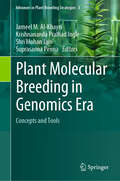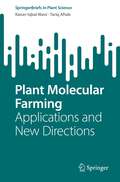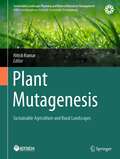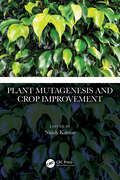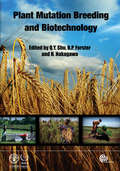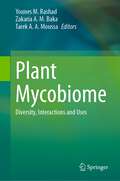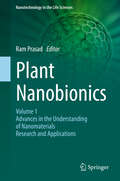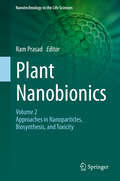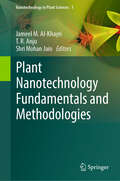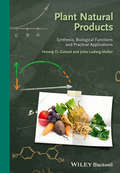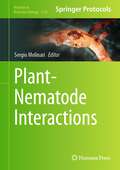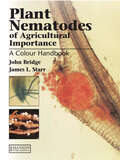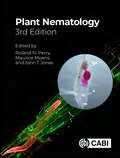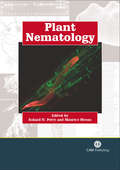- Table View
- List View
Plant Micronutrients: Deficiency and Toxicity Management
by Khalid Rehman Hakeem Tariq AftabPlants require essential nutrients (macronutrients and micronutrients) for normal functioning. Sufficiency range is the levels of nutrients necessary to meet the plant’s needs for optimal growth. This range depends on individual plant species and the particular nutrient. Nutrient levels outside of a plant’s sufficiency range cause overall crop growth and health to decline, due either to deficiency or toxicity from over-accumulation. Apart from micronutrients (B, Cl, Mn, Fe, Zn, Cu and Mo), Aluminum (Al), cerium (Ce), cobalt (Co), iodine (I), lanthanum (La), sodium (Na), selenium (Se), silicon (Si), titanium (Ti), and vanadium (V) are emerging as novel biostimulants that may enhance crop productivity and nutritional quality. These beneficial elements are not "essential" but when supplied at low dosages, they augment plant growth, development, and yield by stimulating specific molecular, biochemical, and physiological pathways in responses to challenging environments.The book is the first reference volume that approaches plant micronutrient management with the latest biotechnological and omics tools. Expertly curated chapters highlight working solutions as well as open problems and future challenges in plant micronutrient deficiency or toxicity. We believe this book will introduce readers to state-of-the-art developments and research trends in this field.
Plant microRNAs: Shaping Development and Environmental Responses (Concepts and Strategies in Plant Sciences)
by Tamas Dalmay Célia Miguel Inês ChavesThis book summarizes the latest findings on the functions of microRNAs in the regulation of plant development and responses to the surrounding environment. MicroRNAs are an important class of molecules that can be found in diverse groups of organisms, including plants and animals, and the investigation of their roles is a highly dynamic and “hot” research topic. The respective chapters address four main aspects, namely: microRNA investigation and annotation, the regulatory roles of microRNAs in various developmental processes, in response to abiotic factors, and in the context of biotic stress response regulation. Systematically reviewing the most important findings in this field, the book offers an essential guide for undergraduate and graduate students, teachers, and plant science researchers. Due to the potential applications of microRNAs in crop breeding and plant protection, it also represents a valuable resource for scientists in academia and the private sector alike.
Plant MicroRNAs
by Pamela J. Green Blake C. MeyersMicroRNAs constitute a particularly important class of small RNAs given their abundance, broad phylogenetic conservation and strong regulatory effects, with plant miRNAs uniquely divulging their ancient evolutionary origins and their strong post-transcriptional regulatory effects. In Plant MicroRNAs: Methods and Protocols, experts in the field present chapters that focus on the identification, validation, and characterization of the miRNA class of RNAs, and address important aspects about heterochromatic small interfering RNAs. In addition, the methods contained in this volume emphasize miRNA analyses, but also include ways to distinguish one class of small RNAs from another. As a volume in the highly successful Methods in Molecular BiologyTM series, chapters include brief introductions to their respective topics, lists of the necessary materials and reagents, step-by-step, readily reproducible laboratory protocols, and notes on troubleshooting and avoiding known pitfalls. Authoritative and easy to use, Plant MicroRNAs: Methods and Protocols provides the research community with a set of protocols that will help advance vital miRNA research for all plant species, both in typical model species and non-model species alike.
Plant MicroRNAs and Stress Response
by Deepu Pandita Anu PanditaMicroRNAs (miRNAs) are small (20–24 nt), single stranded, regulatory RNA molecules or gene regulators of critical transcriptional or post-transcriptional gene regulation in plants in sequence-specific order that respond to numerous abiotic stresses and animals, non-coding, highly evolutionarily conserved and widely distributed throughout the plant kingdom. MiRNAs are master regulators of plant growth and development, development attenuation under various environmental stresses by stress-responsive miRNAs and plant stress responses and tolerance. Drought, salinity, heat, cold, UV radiation, heavy metal, pathogens, pests and other microbial infections affect survival, growth, development, quality, yield, and production of plants. Stress induced miRNAs down regulate their target miRNAs. This down regulation leads to the accumulation and function of positive regulators, highlighting their roles in stress responses and tolerance. Plant miRNA mediated modifications include overexpression or repression of stress-responsive miRNAs and/or their target complementary or partially complementary gene products, miRNA-resistant target genes, target-mimics and artificial miRNAs. Thus, miRNAs may serve as "genomic gold mines", novel, potent and potential targets in plant genetic manipulations and miRNA-based biotechnology will aid plant improvement and crop-plant tolerance to different environmental stresses. This book reviews our recent understanding of plant microRNAs, biogenesis and functions, computational tools and bioinformatics, regulation of plant growth and development, expression studies, and the role of plant miRNAs in various biotic and abiotic stress-response regulation in plants.
Plant Microtechniques and Protocols
by Edward Chee Tak Yeung Claudio Stasolla Michael John Sumner Bing Quan HuangA proper understanding of the structural organization of the plant body is essential to any study in plant biology. Experimental studies in vivo and in situ will lead to structural, physiological, and cellular changes of the experimental material. To study macroscopic and microscopic changes, different histological methods and microtechniques can be used as they provide valuable information of the experimental system. In addition, the observed structural changes allow investigators to set hypothesis for further studies based on one's own observation. Thus, proper selection and utilization of microtechniques are a must for the success of a research program. At present, an up-to-date collection of protocols are not readily available in the literature. The latest work in plant microtechniques was published in 1999 by Ruzin but many others are no longer in print [e. g. , Jensen (1964); O'Brien and McCully (1981)]. Furthermore, a majority of published works focus on techniques related to general processing and staining procedures. A comprehensive treatment that encompasses broader applications of microtechniques to other disciplines is lacking [e. g. , archeology, wood science, etc. ]. There is a need to create a comprehensive volume of botanical methods and protocols which includes traditional and novel techniques that can be used by researchers in plant science and investigators in other disciplines that require plant microtechniques in their research and teaching. This book covers a wide variety of applications and brings them up-to-date to make them understandable and relevant, especially to students using the methods for the first time. It is our intention to create a useful reference for plant histology and related methods that will serve as a foundation for plant scholars, researchers, and teachers in the plant sciences.
Plant Migration: The Dynamics of Geographic Patterning in Seed Plant Species
by Jonathan D. SauerUsing cases of plant migration documented by both historical and fossil evidence, Jonathan D. Sauer provides a landmark assessment of what is presently known, and not merely assumed, about the process.
Plant Mineral Nutrients
by Frans J.M. MaathuisThe study of plant mineral nutrition has both academic and applied aspects to it. Today, research into plant mineral nutrition is more pertinent than ever in the face of a growing world population and the increasing need for sustainable agriculture. In Plant Mineral Nutrients: Methods and Protocols, expert researchers in the field detail a comprehensive collection of methodologies that are routinely used in plant mineral nutrition research. These include methods and protocols for plant growth parameters, ion contents and composition, soil analyses, flux measurements and the use of public facilities for high throughput analyses. Written in the highly successful Methods in Molecular BiologyTM series format, chapters include introductions to their respective topics, lists of the necessary materials and reagents, step-by-step, readily reproducible laboratory protocols, and key tips on troubleshooting and avoiding known pitfalls. Authoritative and practical, Plant Mineral Nutrients: Methods and Protocols seeks to aid scientist in the further study of into plants and their mineral nutrients.
Plant Mitochondria: Methods and Protocols (Methods in Molecular Biology #2363)
by Olivier Van Aken Allan G. RasmussonThis detailed volume presents a wide range of techniques for plant mitochondrial analysis, ranging from tried-and-tested work horse techniques to the latest innovations. Within its pages, it explores subjects such as affinity-based isolation of mitochondria with magnetic beads, mitochondrial quality assessment protocols, measurement of uptake and release of specific metabolites, mitochondrial protein identification and visualization, as well as gene splicing and editing, and much more. Written for the highly successful Methods in Molecular Biology series, chapters include introductions to their respective topics, lists of the necessary materials and reagents, step-by-step, readily reproducible laboratory protocols, and tips on troubleshooting and avoiding known pitfalls. Authoritative and practical, Plant Mitochondria: Methods and Protocols provides a highly useful set of methodologies for the plant mitochondrial community to help discover more interesting aspects of plant mitochondria in the years to come.
Plant Mitochondria
by Frank KempkenMitochondria are the product of a long evolutionary history. It is now a well established fact that mitochondria did evolve from free living bacteria being the common ancestor of both, eukaryotic mitochondria and α-proteobacteria. Advances in genome sequencing, the establishment of in organello and in vitro assays to name only a few, contributed significantly to advances in plant mitochondrial research. Second generation sequencing and the ability to directly sequence and analyse the whole plant transcriptome certainly will help to develop the research on plant mitochondria to another level in the future. In this book the current knowledge about plant mitochondria is presented in a series of detailed chapters, which have been organized in five main sections: (i) dynamics, genes and genomes; (ii) transcription and RNA processing; (iii) translation and import; (iv) biochemistry, regulation and function; and (v) mitochondrial dysfunction and repair. These sections consist of two to five chapters, each written by well-known specialists in the field. This book thus provides a comprehensive inside in the field of plant mitochondria for the specialist. The addition of a glossary and text boxes to each chapter provides easy access for readers from other subjects and hopefully will attract young scientist to the fascinating and exiting field of plant mitochondria.
Plant Mitochondria
by James Whelan Monika W. MurchaThe chapters compiled in this detailed collection outline a number of methods used to study plant mitochondria today, starting from the isolation of mitochondria to detailed analyses of RNA, protein and enzymatic activities. Given that the ability to uncover mitochondria's unique features is underpinned by current methodology, this book explores the subject from morphology to detailed molecular mechanisms. Written in the highly successful Methods in Molecular Biology series format, chapters include introductions to their respective topics, lists of the necessary materials and reagents, step-by-step, readily reproducible laboratory protocols and tips on troubleshooting and avoiding known pitfalls. Practical and authoritative, Plant Mitochondria: Methods and Protocols serves as a vital resource to beginners in the field as well as to expert researchers who find themselves being pulled into the field of mitochondrial research as it links to so many important aspects of plant cell biology.
Plant Molecular Breeding in Genomics Era: Applications (Advances in Plant Breeding Strategies #4)
by Jameel M. Al-Khayri Krishnananda Pralhad Ingle Shri Mohan Jain Suprasanna PennaOver the years, the interventions of genomics tools have paved the way for molecular breeding to meet the challenges of food security and climate resilience. Advances in plant molecular breeding encompassing approaches of genomics, molecular markers, genetic transformation and genome editing have revolutionized crop improvement. Successful application of these tools has led to improvement of a wide range of traits of agronomic relevance. This book provides a comprehensive coverage of successful applications of molecular approaches that can be integrated within plant breeding programs aimed at improvement of crop plants. The book covers all relevant areas of molecular breeding applications in plants, with many examples drawn from the advanced genomics and molecular breeding research. Chapters present a critical appraisal of the current literature in the respective fields of molecular breeding written by expert authors. Each chapter provides in-depth discussion of the subject supported with high-quality color illustrations relevant data and future research perspective and, a comprehensive list of pertinent references.
Plant Molecular Breeding in Genomics Era: Concepts and Tools (Advances in Plant Breeding Strategies #3)
by Jameel M. Al-Khayri Krishnananda Pralhad Ingle Shri Mohan Jain Suprasanna PennaAdvances in plant genomics, plant molecular biology and genome editing have revolutionized opportunities for more efficient plant breeding. Successful application requires a concrete understanding of the concepts. Molecular Plant Breeding is an interface of issues from basic concepts to applications to crop improvement. The tools include molecular marker technology, gene mapping, genetic transformation, precise gene editing, and climate smart agriculture. This book provides a comprehensive coverage of molecular tools and methodologies that should be integrated within plant breeding programs for the improvement of crop plants. The book covers all relevant areas of molecular breeding in plants, with concepts and tools of relevance to plant genomics research and advanced molecular breeding. Chapters comprehensively review the contemporary literature on the subject and reflect the experiences of the authors. Each chapter emphasizes introduction covering related backgrounds and providesin-depth discussion of the subject supported with high-quality color illustrations and relevant data. Chapters conclude with future research perspective and, a comprehensive list of pertinent references.
Plant Molecular Farming: Applications and New Directions (SpringerBriefs in Plant Science)
by Kaiser Iqbal Wani Tariq AftabMolecular farming is a biotechnological approach that includes the genetic adjustment of agricultural products to create proteins and chemicals for profitable and pharmaceutical purposes. Plant molecular farming describes the manufacture of recombinant proteins and other biologically active product in plants. This approach depends on a genetic transformation of plants that can be accomplished by the methods of stable gene transfer, such as gene transfer to nuclei and chloroplasts, and unstable transfer methods like viral vectors. The requirement for recombinant proteins in terms of quality, quantity, and diversity is increasing exponentially This demand is traditionally met by recombinant protein construction technologies and the engineering of orthodox expression systems based on bacteria or mammalian cell cultures. However, majority of developing countries cannot afford the high costs of medicine derived from such existing methods. Hence, we need to produce not only the new drugs but also the cheaper versions of those already present in the market. Plant molecular farming is considered as a cost-effective technology that has grown and advanced tremendously over the past two decades. This book summarizes the advances and challenges of plant molecular farming for all those who are working on or have an interest in this rapidly emerging area of research.
Plant Mutagenesis: Sustainable Agriculture and Rural Landscapes (Sustainable Landscape Planning and Natural Resources Management)
by Nitish KumarThis book emphasizes recent developments in the use of mutation technologies for crop plant improvement and, ultimately, sustainable development. Plant breeders use genetic variation, which is created by plant-induced mutation, to create new and improved cultivars. The development of improved cultivars is a productive and optimistic agricultural strategy for economic and environmental sustainability since it ensures high yield stability, enhances soil health, and poses no environmental risks. Understanding mutation induction and exploring its uses have paved the road for improving genetic diversity for different plants and agronomic features and advanced gene discovery for diverse qualities that aid in sustainable development. Plant mutation breeding imitates spontaneous mutation, the primary force driving evolution, by using a plant's own genetic resources instead of genetic transformation. In order to develop beneficial agricultural features, this strategy focuses on the application of various chemical and physical mutagens in conjunction with biotechnologies. In order to survive in challenging environments, increase nutritional value, fight diseases and pests, grow in salty soils, and utilize water and nutrients more effectively, new varieties of plants are developed.This approach has significantly boosted the economies of nations like China, India, Japan, Pakistan, and the USA. As of right now, the strategy has produced and disseminated more than 3600 mutant types in the majority of crop plants, having a significant economic impact. This book discusses several mutation induction techniques, mutant screening, genome editing, the haploid breeding system for mutations, as well as genomic developments, and mutant gene identification. Plant breeders, researchers, and students in the fields of plant sciences, agriculture, and food science will find this instructive book to be of great help.
Plant Mutagenesis and Crop Improvement
by Nitish KumarCrop improvement using classically induced mutagenesis is now well standardized. Many new promising varieties of different crops have been successfully developed worldwide using both physical and chemical mutagens. Voluminous literature is now available on basic and applied aspects of mutagenesis. The mutation technique has been refined and holds the promise of generating much wider and more desirable variability than classical breeding. Recent advances in technology combined with classical mutation breeding offer new and exciting challenges for the development of new varieties. A global inventory of induced mutagenesis activities for crop improvement is requried. This book covers both basic and applied aspects of mutation and its impact on various crops: it is extremely well prepared and contains a huge volume of information accumulated using classically induced mutagenesis on different crops in different countries. Three key features: Describes the importance of induced mutation in crop plant research and its application to production Highlights new advances in the understanding of plant mutagenesis in crop improvement Contains contributions from major leaders in the field of plant mutation research This volume brings together all the important and relevant literature in the field. It provides a complete account of the mutation breeding of crops, presenting conclusions about the value of the method, its possibilities, limitations, and shortcomings, and the possible difficulties of further application in various crops. The initial chapters deal with the interactions between mutagenic treatment and plant material, such as aspects of mutagenic treatment, postirradiation behavior of shoot apices, and adventitious bud techniques. All available literature is then discussed crop by crop and critically evaluated. This will serve as an extremely comprehensive guide for researchers, teachers, students, and individuals who are interested in using induced mutagenesis as a tool for crop improvement.
Plant Mutation Breeding and Biotechnology
by Hitoshi Nakagawa Qing-Yao Shu Brian ForsterThis comprehensive book covers the underlying scientific principles, state-of-the-art technologies and methodologies of plant mutagenesis. It covers historical development and commonly used terminologies, chemical and physical mutagenesis, mutation induction, mutation breeding and mutations in functional genomics research. Suitable both as a manual for professionals and a resource for students in plant breeding and research, the book includes exemplary cases of practical applications and an appendix of recommended doses of gamma and fast neutron irradiation for almost 200 plant species.
Plant Mycobiome: Diversity, Interactions and Uses
by Younes M. Rashad Zakaria A. M. Baka Tarek A. A. MoussaPlant mycobiome represents a diverse array of plant-associated communities of endophytic and epiphytic fungi. These communities fundamentally affect plant health, development, adaptation, and communication with the surrounding ecosystem. Furthermore, they have key roles in the establishment, diversification, productivity, and sustainability of different natural ecosystems. However, some of these communities are pathogenic for the plant itself or dangerous for the consumers, due to the production of mycotoxins. In other words, plant mycobiome represents two faces of a coin. This book aimed to explore contributions of the plant mycobiome in plant-environment interactions from different perspectives. Chapters of this book address numerous themes covering the recent advances in roles, diversity, and dynamics of these fungi as biocontrol agents, biofertilizers, growth promoters, and their secondary metabolites in the area of crop improvement for sustainability and biotechnology, as well as the plant pathogenic and toxigenic fungi. This book will be useful to postgraduate students, botanists, mycologists, ecologists, plant pathologists, and physiologists.
Plant Nanobionics: Volume 1, Advances in the Understanding of Nanomaterials Research and Applications (Nanotechnology in the Life Sciences)
by Ram PrasadAn improved understanding of the interactions between nanoparticles and plant retorts, including their uptake, localization, and activity, could revolutionize crop production through increased disease resistance, nutrient utilization, and crop yield. This may further impact other agricultural and industrial processes that are based on plant crops.This two-volume book analyses the key processes involved in the nanoparticle delivery to plants and details the interactions between plants and nanomaterials. Potential plant nanotechnology applications for enhanced nutrient uptake, increased crop productivity and plant disease management are evaluated with careful consideration regarding safe use, social acceptance and ecological impact of these technologies.Plant Nanobionics: Volume 1, Advances in the Understanding of Nanomaterials Research and Applications begins the discussion of nanotechnology applications in plants with the characterization and nanosynthesis of various microbes and covers the mechanisms and etiology of nanostructure function in microbial cells. It focuses on the potential alteration of plant production systems through the controlled release of agrochemicals and targeted delivery of biomolecules. Industrial and medical applications are included. Volume 2 continues this discussion with a focus on biosynthesis and toxicity.
Plant Nanobionics: Volume 2, Approaches in Nanoparticles, Biosynthesis, and Toxicity (Nanotechnology in the Life Sciences)
by Ram PrasadPlant Nanobionics, Volume 2 continues the important discussion of nanotechnology in plants, but focuses with a focus on biosynthesis and toxicity. This book discusses novel approaches to biosynthesis of nanoparticles for the increase of plant production systems, controlled release of agrochemicals and management of plant biotic stress. Green biosynthesis of metallic nanoparticles from bee propolis, artificial photosynthesis and hybrid structures are presented.Although engineered nanoparticles have great potential for solving many agricultural and societal problems, their consequences on the ecosystems and environment must be responsibly considered. This volume aims to contribute to the limited literature on this topic through its comprehensive examination of nanoparticle toxicity on plants, microbes and human health. Environmental risks with recent data are discussed as well as risks associated with the transfer of nanoparticles through the food chain. This volume highlights the study of a mechanistic approach and the study of nanoparticles towards nanobionics. The application of polymeric materials for smart packing in the food industry and agriculture sector as well as the future of nanomaterials in detecting soil microbes for environmental remediation are also included.
Plant Nanotechnology Fundamentals and Methodologies (Nanotechnology in Plant Sciences #1)
by Jameel M. Al-Khayri T. R. Anju Shri Mohan JainThe book provides an accessible introduction to the core concepts of nanotechnology, the interactions between plants and nanoparticles, and the basic techniques for delivering nanoparticles to plant systems. It offers detailed methodologies and in-depth discussions on the intersection of nanotechnology and plants. The chapters are organized to convey fundamental ideas and provide a comprehensive understanding of plant nanotechnology for readers of all levels. Currently, there is a lack of books addressing interdisciplinary research with a precise overview, and this book can fulfill that demand. The book will serve as a valuable source of fundamental and up-to-date information in the field of plant nanotechnology for graduate students, research scholars, academicians, and scientists from various disciplines.
Plant Natural Products
by Jutta Ludwig-Müller Herwig O. GutzeitIn contrast to existing books which either focus exclusively on the pharmacological properties of plant natural products or cover the secondary metabolism of plants as one section in general plant science book, this is the first to cover all aspects in one volume. It has all the features of a modern textbook, including color figures, questions and answers and a complimentary website. In addition, the introductory chapters provide sufficient background knowledge in the chemistry and biochemistry of plant natural products and their biotechnological applications to allow its use as a true stand-alone text for student courses.
Plant-Nematode Interactions (Methods in Molecular Biology #2756)
by Sergio MolinariThis volume explores the latest advancements and techniques used by researchers to work with plant parasitic nematodes (PPNs) and to study their interactions with crop plants. The chapters in this book cover topics such as ways to obtain samples from soil and different plant tissues; rearing nematodes in greenhouse setting; methods used to axenically rear nematodes in vitro; Denaturing Gradient Gel Electrophoresis (DGGE) separation; methods for ROS detection and hydrogen peroxide quantification; methods to elicit plant resistance against nematodes; methods for the detection of Pathogenesis Related (PR) genes that are the executioners of immunity in plant-RKN interactions; and laboratory procedures that test nematodes on their isolation, count, culture, identification, pathogenicity, virulence, and environmental tolerance. Written in the highly successful Methods in Molecular Biology series format, chapters include introductions to their respective topics, lists of the necessary materials and reagents, step-by-step, readily reproducible laboratory protocols, and tips on troubleshooting and avoiding known pitfalls.Cutting-edge and thorough, Plant-Nematode Interactions is a valuable tool for any researcher interested in learning more about this interesting and developing field.
Plant Nematodes of Agricultural Importance: A Colour Handbook
by John Bridge James StarrThe microscopic soil and plant nematodes that are parasitic on crop plants can be very damaging, and are generally not visible to the naked eye. Their microscopic size means that associating them with crop damage is mainly dependent on determining the symptoms of their effects on plants or plant growth. The damage and symptoms caused can be visible
Plant Nematology
by Maurice Moens Roland N. Perry John T. JonesPlant-parasitic nematodes are a major threat to crop production in all countries, and identification of nematodes and knowledge of their biology is of paramount importance. Providing a broad introduction to nematodes as plant parasites, this book begins by describing nematodes by genera, and then builds on this foundation to detail nematode biology and pest management, including resistance, and biological and chemical control. This 3rd edition is updated to address advances in our knowledge of plant-parasitic nematodes, particularly concerning the molecular aspects of host-parasite relationships, including the application of genomics to nematode biology. Changes in control and management strategies are also covered. The influence of climate change on plant-parasitic nematodes is addressed in a new chapter on ecology. Primarily aimed at students (MSc and PhD), this book is also invaluable for researchers and lecturers in nematology, plant pathology and parasitology, advisory and quarantine services, and crop protection scientists.
Plant Nematology
by Roland N. Perry Maurice MoensThis book provides an overview of plant-parasitic nematodes.
